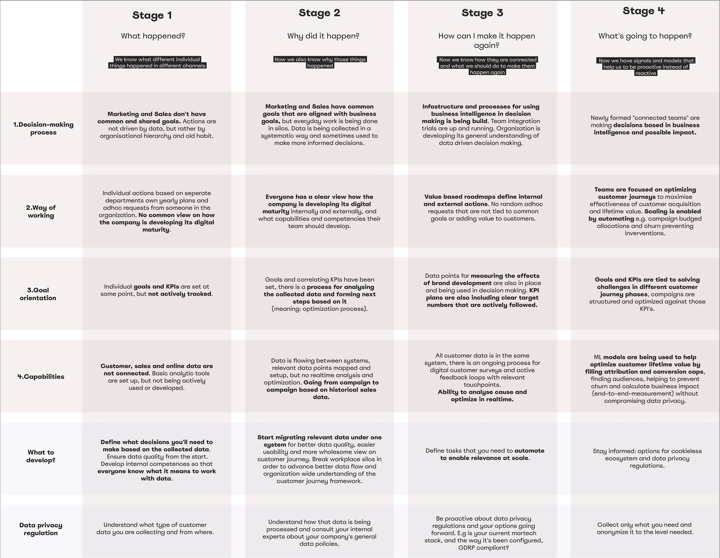How to start developing your marketing department’s digital maturity
Now in 2022, as many companies have set marketing as the main driver for their commercial growth, there is a strong need for marketing organisations to develop their digital maturity. Just being present in digital channels doesn’t bring any leverage anymore and as Boston Consulting Group states in their recent study, brands with high digital (marketing) maturity are more than twice as likely to grow market share. The general discussion has shifted from the brand's digital presence to how well it can drive growth by using data.

Four typical stages of digital maturity development
As we all know, it’s not an easy task to shift marketing departments' purpose from creating awareness and engaging customers to driving business impact and proving results. I’ve mapped out four typical stages of digital maturity development from the perspective of marketing and web sales, but as topics, these should naturally interest the entire organisation. Any CEO should be as interested in the answers to these questions as marketing or sales directors.
Stage 1:
Do we know what is happening in our customer touchpoints such as social media, website, webshop or offline stores? And are we collecting the right data from those points? Where are we storing the data and how are we processing it?
– If you’re not sure about the answer, but would like to know, you’ve just taken the first step in your marketing organisation's digital maturity development.
Stage 2:
Do we know why all these events happened and how e.g. our marketing events are connected to different sales events? How much revenue are our marketing efforts generating?
– Don’t worry, most companies don’t have a clear view of this. But they are probably relentlessly developing the capabilities to track those connections, so make sure you’re ahead of your competitors.
Stage 3:
Do we know how we can make that sudden growth spike in web sales or improvement in customer satisfaction or brand awareness happen again? Are we able to analyse the cause?
– Few can, and they are very likely getting a huge advantage from it.
Stage 4:
Do we know how to be proactive instead of just reacting to new situations or future customer needs?
– Probably not since those capabilities are still quite expensive to build and can bring leverage to only a few big companies with huge amounts of data. But a lot of new, not custom made solutions have become or are coming available soon. So time to start looking into those and learning about new use cases.

I’ve also created four internal development streams for each stage. First and second we have a decision making process and way of working. In my opinion, these are the main enablers of data-driven marketing. If an organisation holds on to old hierarchies, past beliefs and internal siloed competitiveness, it doesn't matter how well functioning data collection and analysis processes have been set up, it won’t translate into business impact because there is no room for data-driven decision making. That means that the organisational structure and culture are the main enablers for digital maturity development.
After those are the level of goal orientation and tech capabilities, topics that have been traditionally thought to be the backbone of data-driven marketing. And of course, they are, if organisational matters have already been solved. Your goal setting and KPIs plan should give you a good view of what actions impact business and where organisation-wide cooperation is needed to get the best results. After you know what impacts business, then you also know the direction your martech capabilities should be developed.
To be able to develop your digital maturity, it is important to know where you stand currently and where you want to be in the future. If you feel overwhelmed by it all and not sure where to start, you can always bring in external hands to help you to clarify the next steps. We at Avidly are of course more than happy to help you with that.
If you want to start right now and need a few pointers, here are some very concrete development ideas:
Stage 1: What happened?
First step: Define very clearly what decisions you and your team need to make to create business impact (Goal setting and KPIs planning). E.g. Do you need to know what content or channels currently bring in the most revenue? That information will enable you to allocate your resources better and tell you what type of expertise you need right now.
Stage 2: Why did it happen?
First step: Map your Customer Journey to the level you’re capable of right now. Collect all the available data into one view, see what you already know and most importantly what you don’t know. Take 1 customer problem that will have the biggest business impact and 2 smaller problems that are quick to solve. Have weekly follow-ups and track the effects. When they have been solved, move to the next 3 tasks.
Stage 3: How can I make it happen again?
First step: Move from analysing past individual campaigns to ongoing real-time conversion optimisation. Divide your KPIs and budgets to conversion level and brand level to make sure there is always enough resources dedicated to both, so continuous incoming revenue and brand development go hand in hand. With modern tools, you can start measuring the effects of your brand level efforts to enable data to guide budgeting.
Stage 4: What’s going to happen?
First step: Find out in as much detail as possible how different events are connected, fill in missing attribution caps and get a better view on conversions. New ePrivacy related regulations are making actual events more difficult to follow, so you’ll probably need the help of machine learning models. The easiest way to do that is by starting to use Google Analytics 4 and its new features such as ML modelling.
On the way to change? Read the third part of our article series, Change must be led by the person first, where we discuss change management together with university teacher and PhD candidate Tommi Mäkinen. Mäkinen teaches at the University of Jyväskylä, e.g. emotional and interaction skills and themes related to supporting community. With him, we go through the difficulty and fears of managing change, and how change situations can be made easier for all parties involved.
Real Growth. Real Impact.
HubSpot for startups: Leveraging the platform and unlocking growth w. Ragini Campion
Making AI adoption not a big deal with Mike Kaput from The AI Show
HubSpot's Spring Spotlight 2025 was not what we expected
The Power of Community in Marketing
The Return of Human Marketing in an Automated Age | Avidly Talks
How to make change projects a success - Change management tactics
How to prompt AI for great creative ideas
See why enterprises choose Avidly
Let’s build your HubSpot success story
Compelling final call to action - with accompanying link to Contact page









